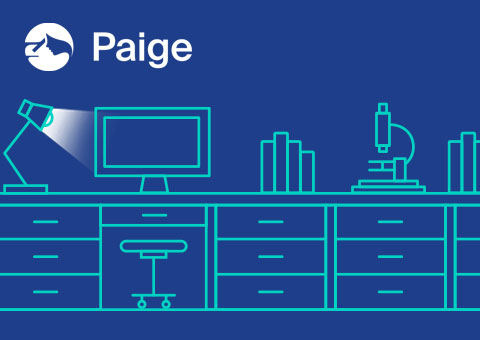Like most global healthcare professions, cancer care has weathered a challenging storm the last few years. While vulnerable patients and healthcare workers were asked to self-isolate in response to the COVID-19 pandemic, cancer screening and other non-COVID related services were paused in many countries. As a result, patients were left awaiting diagnoses for longer stretches of time, while care teams faced mounting pressures.
Even prior to the pandemic, pathology services were squeezed by increased lab testing and a growing number of cancer cases globally. Many countries also struggled to recruit new students into this specialized area of medicine, leaving existing pathologists to retire often without a replacement. In fact, in a 2018 study, The Royal College of Pathologists in the UK found that only 3% of histopathology departments had enough staff to meet their demand on clinical lab services. [1]
To compound these challenges, the International Agency for Research on Cancer (IARC) estimates cancer rates are set to grow to over 27 million new cases per year worldwide by 2040, up 62% from 2018. [2]
Under these growing demands and scarce resources, how are pathology labs expected to keep pace? The answer can only be transitioning to digital pathology. Whole-slide imaging, digital workflows, and clinical-grade AI – all important elements of digital pathology – present incredible opportunities for transforming pathology both on the day-to-day and in its overall growth as a field.
Why Digital Pathology?
The adoption of digital pathology requires many steps, but has a wide range of immediate impacts for pathologists, labs, and health systems including:
Greater Field of View
Microscopes have a fixed field of view, where digital viewers provide the opportunity to see multiple images at once.
Slide Preservation
Whole-slide images allow slide sharing digitally rather than by shipping glass slides, so that the chance of the glass slide and the critical information it holds getting broken, damaged, or lost is removed.
Collaboration
Digital pathology opens up the opportunity to collaborate with any pathologist, anywhere in the world, in moments. This speeds up review time and encourages cross-collaboration.
Remote Sign-out
Remote working has become the new normal for many industries following COVID-19, and thanks to digital pathology tools, pathology is no exception. The CMS/CLIA in the US approved digital remote sign-out to allow pathologists to sign out cases anywhere with an internet connection. [3]
Decision Support
Whole slide image viewers give pathologists the ability to zoom, measure, annotate, and sort in ways that traditional microscopy cannot support, ultimately giving pathologists greater diagnostic confidence.
Greater Efficiency
A study conducted in 2017 found that pathologists in the Granada Hospital Network, an early adoption site for digital pathology tools, experienced a 21% increase in diagnostic capacity compared to microscopy when using a digital workflow for primary histopathology diagnosis. [4] Digitizing a lab’s workflow can also help pathologists prioritize cases and structure their time more effectively.
Improved Accuracy
A significant benefit of digital pathology is the ability to utilize powerful AI tools directly in the workflow. AI can be used to quickly and accurately identify patterns that could indicate areas of interest most likely to harbor cancer, even in especially small or complex cases.
Lab Innovation
Digital pathology has the potential to attract a whole new class of talent and retain existing pathologists who may need the flexibility it provides. Importantly, going digital also keeps labs on the forefront of the industry, setting them up for success in the long term.
It is worth noting that digital pathology and AI technologies are not designed to replace pathologists. Instead, these tools support pathologists in delivering an accurate and efficient diagnosis, the impacts of which carry downstream to the rest of the cancer care team and ultimately to the patient.
Of course, the impact to the patient is what makes it worthwhile to transition to digital pathology, despite its challenges. For instance, a significant barrier to entry for many labs is the high cost of scanners, IT infrastructure, and other digital tools. Further, new tools means a new workflow, which takes time to set-up and train pathologists on. However, all of these challenges can be mitigated by selecting the right partner in your digital transformation. Taking the time to go under the hood with a technology vendor, trial their tools, and work in direct collaboration on your challenges can help reduce the burden of overwhelming choice.
At Paige, we have taken every care to make implementing Paige products as seamless as possible. Our cloud-based platform is compatible with most major scanner vendors and LIS systems, and our dedicated customer success teams works with labs every step of the way to ensure a smooth transition from analog to digital. Importantly, our viewer and AI applications are intuitive, designed by pathologists, for pathologists to easily assist in reducing errors and enhancing pathologists’ efficiency.
Implementing a range of digital pathology solutions can help address the many pressures pathologists face today and reduce the increased workloads expected in the future. It is those labs that make the switch to digital today that lay the foundation for better pathology workflows, streamlined cancer care, and more precise treatments in the long term.
“Cancer is not a diagnosis until a pathologist says so. The Paige team is working on advancing how a pathologist uses technology. Our goal is to support pathologists, increasing efficiencies and confidence— ultimately optimizing diagnostic process.” Andy Moye, CEO Paige.
___
- Royal College of Pathologists. “Meeting Pathology Demand: Histopathology Workforce Census.” London, England: Royal College of Pathologists.(2018).
- American Cancer Society. “Global cancer facts & figures.” Cancer.org (2018). https://www.cancer.org/research/cancer-facts-statistics/global.html
- College of American Pathologists. “COVID19 – Remote Sign-Out Guidance.” Cap.org. (2020). https://documents.cap.org/documents/COVID19-Remote-Sign-Out-Guidance-vFNL.pdf
- Retamero, JA, Aneiros-Fernandez, J, & Del Moral, RG. “Complete Digital Pathology for Routine Histopathology Diagnosis in a Multicenter Hospital Network.” Archives of Pathology & Laboratory Medicine 144.2(2020):221-228. https://www.archivesofpathology/

